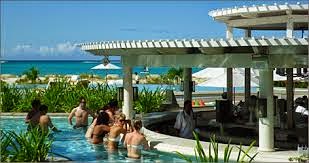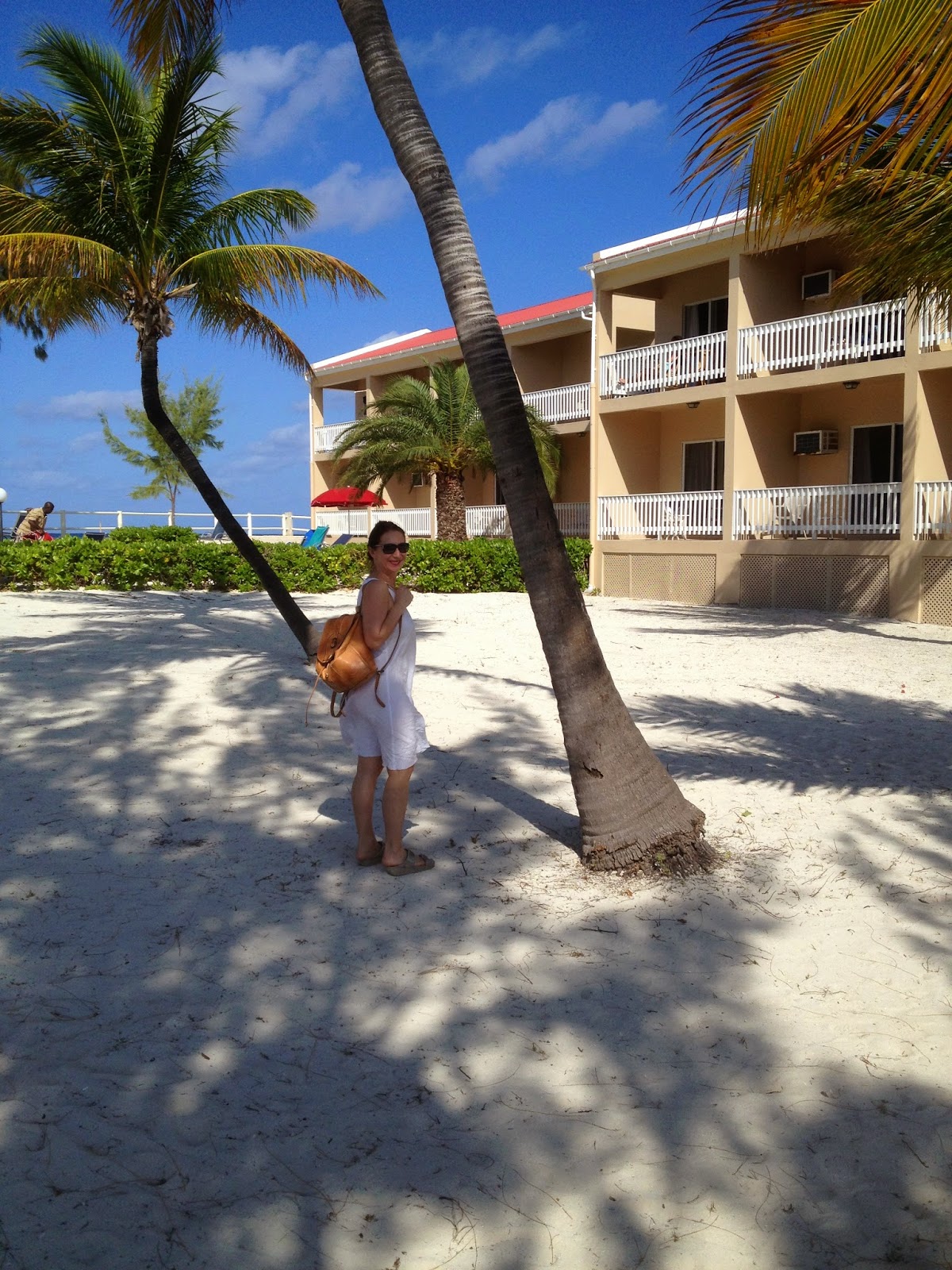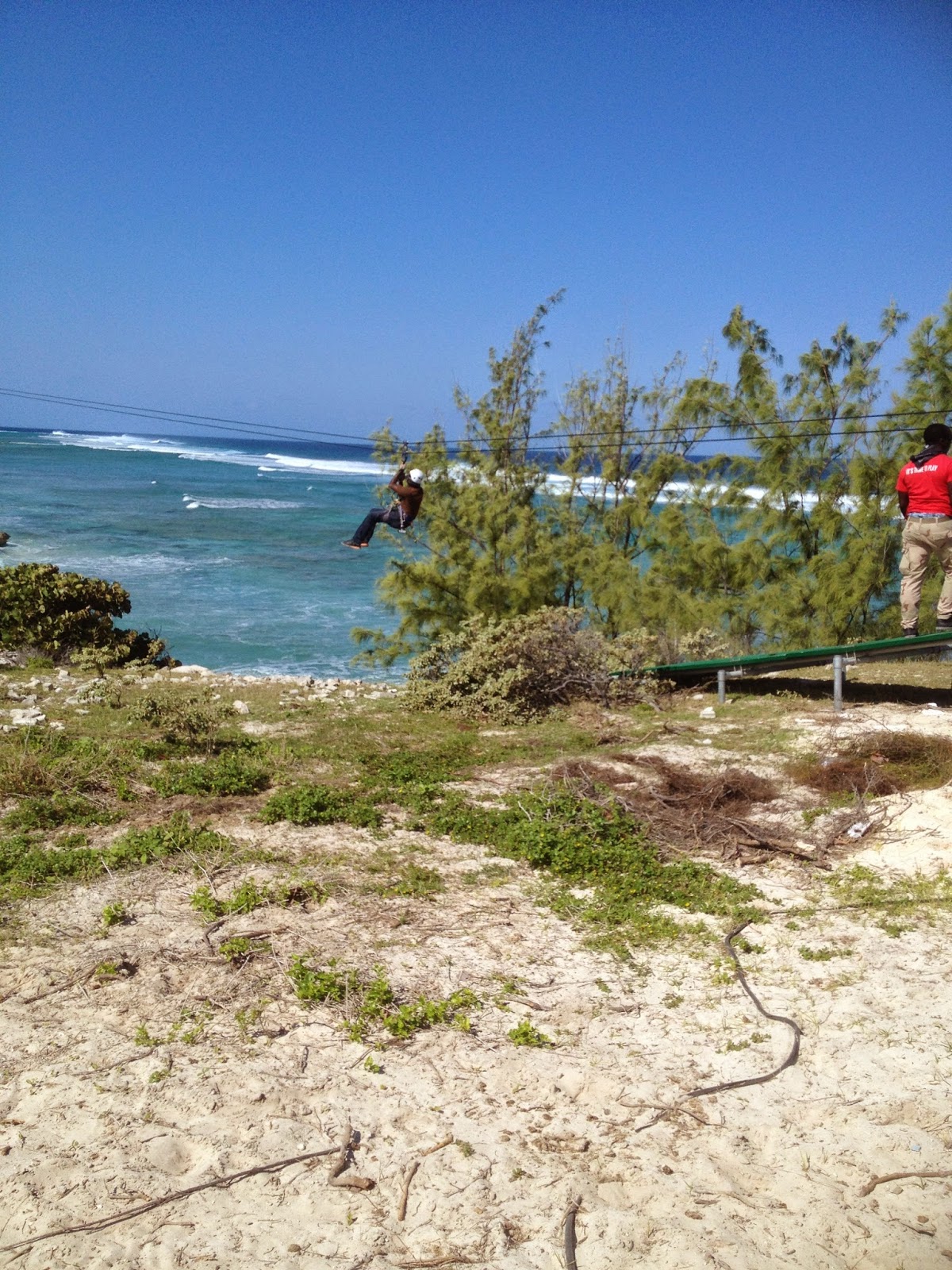So, we booked a 7-day cruise down in the Caribbean on the Holland America cruise line and left sunny Florida in the middle of February.
The Eurodam headed out out of Ft Lauderdale, cutting through a 30 mile per hour chilly wind off the port bow for the next night and day, churning up the angry deep blue sea, white cyclones of wind-blasted water, constantly bouncing off the massive steel vessel as it sliced through the Caribbean Ocean at 16 knots, a billion busted waves, following in our wake like wind born fury, spinning off in every direction to who knows where.
No matter, we were just passing through on our way to Grand Turk in the Turks and Caicos Islands, and a couple hundred miles out, that cold wind that had been steadily battering us from the east, and stealing our joy, finally turned blessedly warm.
As I stood there on our ocean perch balcony — ALWAYS get a balcony! — I realized it was finally time to take off my clothes.
GRAND TURK
The first thing that our well-spoken driver Harold told us when we piled into his big red tour van was, "If you came looking for luxury, or fancy hotels, then you came to the wrong island."
Turks and Caicos consists of 40 islands — only 10 of them are inhabited.
The Turks and Caicos get their name from the Turk's-cap cactus and the Lucayan term caya hico, meaning string of islands. As with much of the Caribbean, the first inhabitants were Taino Indians who arrived between AD 500 and AD 800.
In 1512, the brutal explorer Juan Ponce de Leon "discovered" the islands and claimed them for the Spanish crown. During the next three centuries, the islands were ruled by the Spanish, French, and finally the Brits. But no colonial power ever established a settlement on the islands. From a practical standpoint, the Turks and Caicos islands have always been the Caribbean's red-haired step child.
The first white settlers were British loyalists fleeing America after the Revolutionary War and they grew cotton on the island for export.
Pirates also used the islands in the early Eighteenth Century as a hideout while plundering the high seas.
In 1680, salt merchants descended upon the Grand Turk from Bermuda, bringing along their African slaves to do the hard labor.
In 1799, the islands were officially annexed by the Brits and became a part of the Bahamas. That's when the salt business really kicked into high gear. Grand Turk's claim to fame were its salinas, where they extracted the prized mineral from large man made sea water catch basins running through the middle of the island like shallow ponds. A fleet of ships delivered the white gold as far away as Canada and New York well into the Nineteenth Century. The salt business is long gone but the salt ponds still remain as a reminder of Grand Turk's once lucrative trade with the rest of the world.
"Grand" Turk must be a play on words, or perhaps just wishful thinking. Because it could never live up to its name. I mean, the water's pretty and the beach sand is soft and white, but the rest of the island is pretty bleak.
Grand Turk is as flat as a board, on average, about 5 feet above sea level, with no lush tropical vegetation other than some nice palms along the ocean. It is mostly hard scrabble, rocky white dirt interspersed with cactus. In short, it is remarkably nondescript.
The whole place is just one big hurricane away from total annihilation.
There are 9 hotels on Grand Turk, merely ramshackle guest houses on the ocean. It is all quite primitive.
Turks and Caicos is not an independent nation, but rather, a part of the British Commonwealth. Waterloo, a lush hideaway at the edge of town is the home of the British Governor who rules alongside the island's elected leaders.
But Carnival Cruise Line is the true overseer of the island and they call the shots. They control the Taxi Commission which decides which drivers get to lead the tours when the cruise ships are in town. It is all very orderly with fare zones determining rates so that you can't get ripped off, and the drivers are dressed neatly in colorful red polo shirts with the Turks and Caicos taxi logo.
These days, Grand Turk is famous for being the place where John Glenn's Friendship 7 Mercury spacecraft splashed down in 1962. A little monument over by the airport commemorates the event in true Disney-like fashion.
Harold, our tour guide, was a genial retired government islander with a white beard and high-pitched laugh. He seemed genuinely proud to share his knowledge of the place he had called home for 64 years. He spoke with a laid back eloquence that was quite disarming and left us wondering how such a worldly man could spend his whole life in such a backwater oasis.
The tour cost $25 per person for two hours, with stops at Pillory Beach, the historic Grand Turk Lighthouse on the rocky limestone bluff above the island's northern tip, then over to the highest point of land on the island — maybe fifty feet of rocky nothingness overlooking the old central salinas which is now the island's landfill and car graveyard — and then a final stop in sleepy downtown Cockburn Town.
Water is tricky business on an island with no natural springs and sea water intrusion from underneath the porous limestone. The inhabitants get their water from two primary sources: a desalination water plant and mandatory cisterns attached to each house. Water is now the island's most precious commodity.
Everything the islanders need to survive arrives on the Carnival cruise ships twice a week. And that makes every item, from food to home building supplies, very expensive — gas was $6.20 a gallon when it was going for $2 back in the States. Essentially, Grand Turk is like the International Space Station, only in the Caribbean.
The people are not unfriendly but pretty much oblivious to all the tourons fresh off the big cruise ships. Even the people selling their native wooden, shell, and cloth trinkets were indifferent, rarely making eye contact and seeming not to care whether we bought anything from them or not. Everyone seemed eternally bored out of their minds.
Wild dogs are one of the island's biggest problems and they are everywhere, roaming silently in small packs. They are pretty friendly, moving languidly across the barren landscape like sleepy street beggars. It is very sad.
Canadian vets have recently volunteered their services pro bono, trying to get a handle on the number of strays by inserting microchips in their ears. Monitoring, of course, doesn't actually resolve the problem, but I guess it's a first step.
You can tell the wild dogs from those who have a home by which ones have collars. Oddly, we saw no puppies.
The dog problem has been festering for many years, and our guide told us a funny story about how they used to round up all the wild dogs and put them in a large shelter. But soon there were rumors that the dogs were being mistreated. So one night, the popular British Governor, John Kelly, went to the doggie jail with a crowbar and broke the lock on the fence, setting them all free to roam the island once again. John Kelly is fondly remembered by the islanders as a hero and a real character.
Apparently, culling the troublesome animals has never been a viable option. The islanders just really like dogs. But not enough to take them home.
And there are also thousands of wild donkeys roaming the island like sleep walking tramps. They stand with heads bowed, nibbling at the sparse vegetation dotting the cactus-covered ground. It reminded me of the godforsaken cattle left to nibble out a harsh existence in the American Southwest. The whole island looked like it had been overgrazed for a very long time.
The donkeys are yours for the taking, though it is unclear what you might do with such a treasure. They hearken back to a time when donkeys were the island's primary form of transportation and beasts of burden for the salt trade. With the advent of cars, and the death of the salt empire, the donkeys were set free to listlessly roam the island like lost souls.
And even though milk goes for $10 a gallon, they no longer milk the cows on the island as they used to because the younger folks no longer know how to milk a cow.
Like so many islands in the Caribbean, Grand Turk defines itself in time and space by a hurricane. Hurricane Ike hit the island in September 2008, just as the economic meltdown was destroying the world's economies. Ike damaged every structure on the island, and many of houses have never been rebuilt.
European Union (EU) hurricane relief money took years to finally get to the island, and then it was only made available to about 40 elderly or infirm people who were actually living in their houses when the hurricane hit. If you fled the hurricane, then tough luck. These new two-bedroom homes are looked at with great envy by the vast majority of islanders who received no aid or financial assistance.
For me, the most depressing thing about Grand Turk was the trash. It was EVERYWHERE! And it is part and parcel of a familiar formula in the Third World: Poverty = Trash = A General Lack of Pride.
One of America's biggest exports to the Turks and Caicos islands are the winter winds that arrive in February like clockwork. They have lost their chilly bite by the time they hit Grand Turk, but none of their punch. And it makes for rough waves and captivating vistas. But you have to be very careful about where you swim. The rip currents are treacherous.
Our island tour was very entertaining. We drove along the badly potholed Lighthouse Road that Carnival has been promising for years to repair. They would be the main beneficiaries because when their ships stop at Grand Turk, they take their passengers out to the historic 60-feet-tall Lighthouse designed by British architect Alexander Gordon in 1852. Mules grazed the grounds and were happy to be petted.
There is also a very rustic, Rube Goldberg-looking zip line center at the lighthouse, offering a thrilling ride over the stormy rocks below. The park was not open on the day we visited but I watched a few listless young men apparently being trained by an instructor in his teens. It was quite comical when one of the trainees was left hanging over the rocks at about the midway point and then had to be hauled back to the top by his friends. Maybe it was all part of a rescue drill. Or maybe the downward angle was insufficient to propel the rider to the far end of the line. But no one seemed to mind and everyone was having a good time.
There is a Community College at the old US Navy base near the Lighthouse. All of the abandoned American military facilities have been re-purposed. The tiny international airport is the former home of the old US air base.
The island's pride and joy is the new modern hospital where the national health care system provides first class medical services in the middle of nowhere. The hospital was a joint partnership between the island, the Brits, the EU, and is a part of Britain's National Healthcare Service. No one has to pay a dime.
Our driver asked us about how Obamacare was working out. We explained that it was still a work in progress, but that it had been long overdue.
Harold seemed genuinely surprised. "You are the first Americans that I have ever met who are in favor of the program."
To which I replied, "That's because most of the people who take cruises tend to be older folk, and they have forgotten that the 'socialized' safety net they seem to fear so much under President Obama's new health care plan actually started many years ago with their generation when Congress created Medicare and Social Security. And I don't see any of them refusing their monthly checks. Perhaps it's just a case of selective amnesia."
"You may be onto something," nodded Harold with his boyish giggle.
Other than Carnival Cruise Lines, there hasn't been a lot of foreign investment on Grand Turk, and unlike most of the popular Caribbean islands, we didn't see a lot of luxurious vacation homes. A few wealthy islanders have million dollar homes on the one hill at the north end of the island on a rocky ridge above an exposed cliff that was getting pounded by waves, white spray towering over a hundred feet into the air like icy columns. But for the most part the homes on the island were modest concrete structures.
There is some partially subsidized housing on the island. The land where the Breezy Brae community is located was sold exclusively to locals at bargain prices and their pink, beige and yellow houses with red roofs dot the rocky landscape like untended flowers.
Unlike many Caribbean islands, the crime rate on Grand Turk is very low. Harold said that was because everybody knows one another, so it is virtually impossible to get away with anything.
Grand Turk is so small that most tourons don't take the guided tours. Instead, they rent golf carts, Segways, or ATV's to get around the tiny island. You can easily see everything in a few hours.
After our little tour around Grand Turk, we joined the other 2,000 passengers from the Eurodam at the sprawling tropical Margaritaville complex right next to the cruise ship terminal on White Sands Beach, where it's always 5 o'clock and they serve "paradise cheeseburgers". The place reminded me of the Tropicana resort in Vegas where Inna and I spent our honeymoon. There was an amoeba-shaped swimming pool the size of a football field. They provide rows and rows of free chaise lounges and the water was photo shop turquoise. The snorkeling was okay — nothing special — with the standard tropical fishies feeding off of old anchors and cannons strategically positioned on the white sandy bottom. Jimmy Buffet serenaded us from the monster sound system near the pool, reminding us about those changes in attitudes and changes in latitudes, and we finally felt like we were really on vacation.
There was no Internet, e-mail, phones, or world news. It was just sun and sea and Margaritas — that "frozen concoction that helps me hang on".
The best thing about Grand Turk was that we were finally warm. It had been early October since I had worn shorts, a short-sleeve shirt, and flip flops.
Inna smiled and said, "It feels just like hay-vun."




























































No comments :
Post a Comment